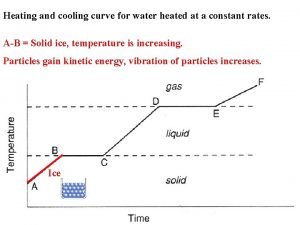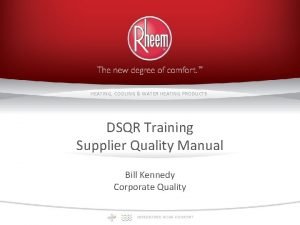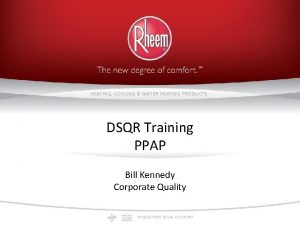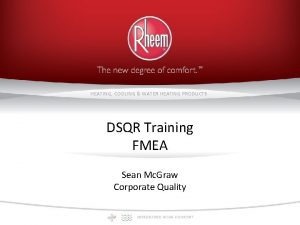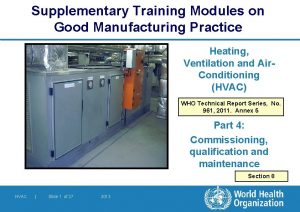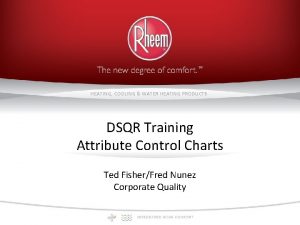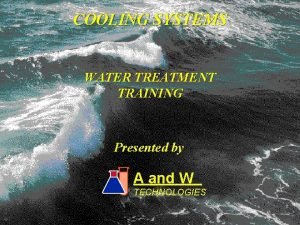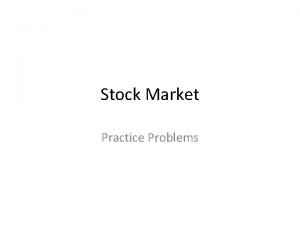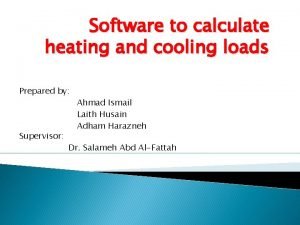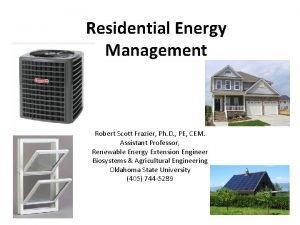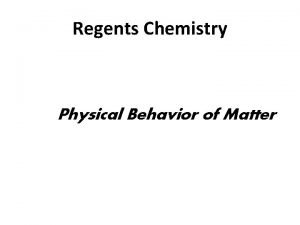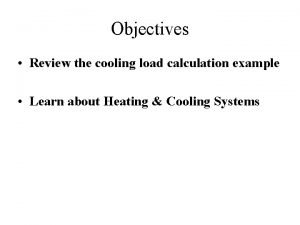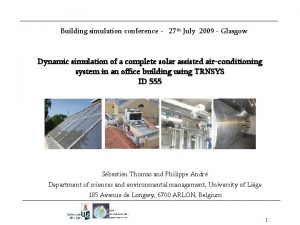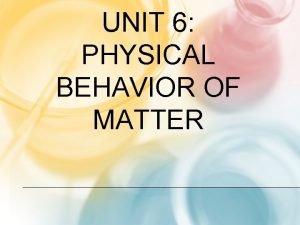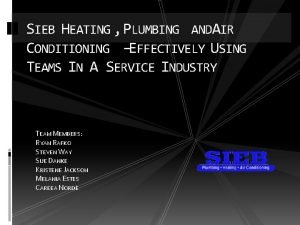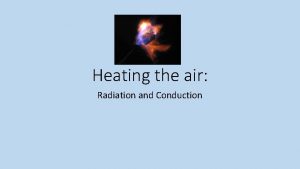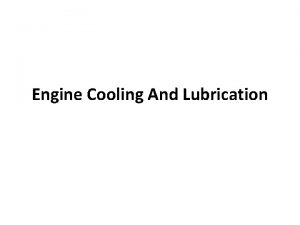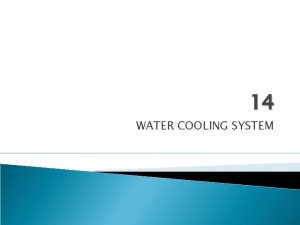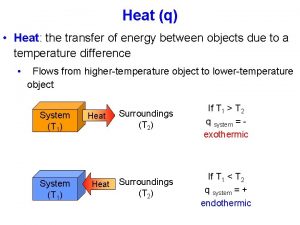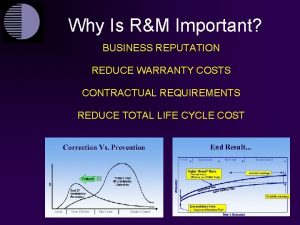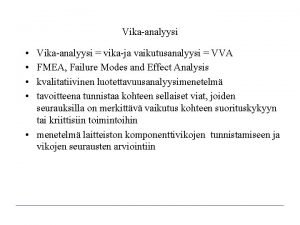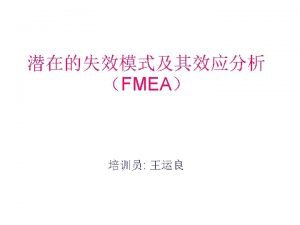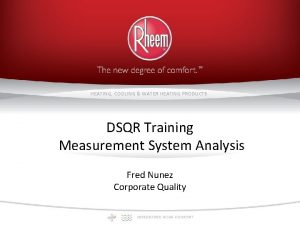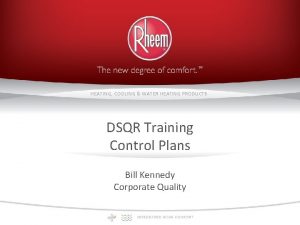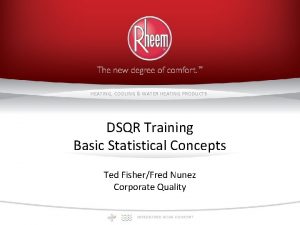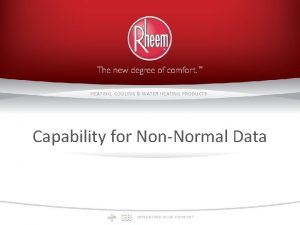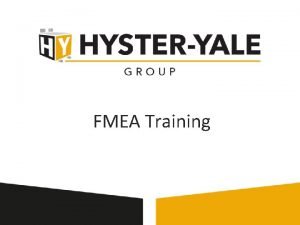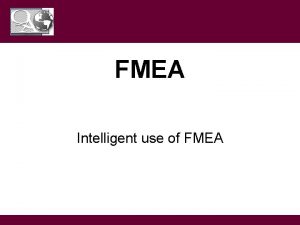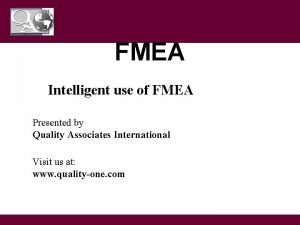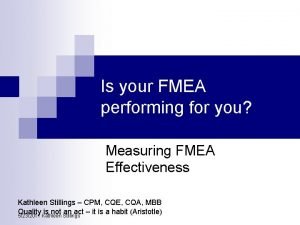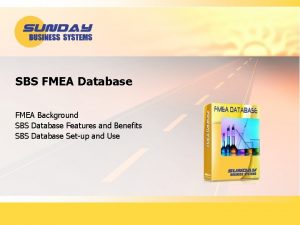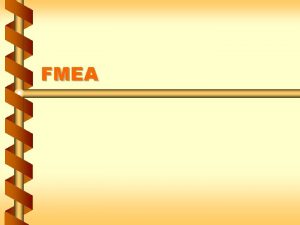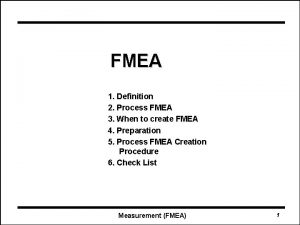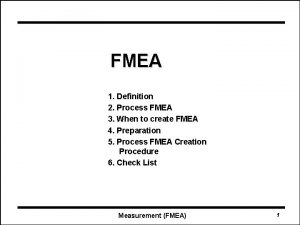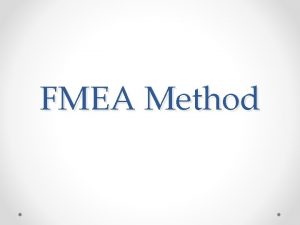HEATING COOLING WATER HEATING PRODUCTS DSQR Training FMEA







































- Slides: 39

HEATING, COOLING & WATER HEATING PRODUCTS DSQR Training FMEA Sean Mc. Graw Corporate Quality

FMEA Training Objectives • Understand a FMEA • Recognize different types of FMEA’s and benefits FMEA’s provide • Understand the components of a FMEA • Recognize and prioritize risks

FMEA Training Definition - FMEA - Failure Mode and Effects Analysis (FMEA) is a systematic process for identifying potential and/or known failures, problems and errors from the system, design process and/or service with the intent to eliminate them or minimize the risk associated with them (American Society of Quality). Summary: Identify ways the product or process can fail and eliminate or reduce the risk of failure

FMEA Training A Structured Approach • Identifying the ways in which a product or process can fail • Estimating the risk associated with specific Failure Modes • Prioritizing the actions that should be taken to reduce the risk • Evaluating the design validation plan (Product) or current control plan (Process)

FMEA Training FMEA – Is / Is not • It is: – Systematic approach to identifying known or potential failures, errors, or problems – Complementary to the design process and/or product development – Means to minimize or eliminate potential failure modes • Is not: – The sole problem solver; used in combination with other problem solving tools (opportunity not solution) – One and done endeavor; needs to be treated as a living document throughout the product life.

FMEA Training FMEA - Benefits / Shortfalls • Benefits – – – Helps identify potential failure modes early in product development Helps in development of manufacturing/assembly control plans Creates priority for product/process improvement Risk management tool Greater organizational support contributes to a more robust product/process • Shortfalls – Individual vs. Team development – Check in the box development vs. improvement to product/process – Late development of FMEA prevents impact to product/process development – Not continually updated

FMEA Training FMEA - Types • System FMEA – Evaluates/analyzes systems in conceptual stages • Design FMEA – Evaluates/analyzes product design and failure related to design issues • Process FMEA – Evaluates/analyzes manufacturing processes and failures related to manufacturing of the product • Service FMEA – Evaluates/analyzes services prior to reaching the customer

FMEA Training Assumptions • For a process FMEA, it is assumed that the design is correct. The product designed will meet the designed intent (AIAG FMEA Manual). • At any process step during the development of the FMEA, it should be assumed that the incoming materials/parts are correct to that process step (AIAG FMEA Manual).

FMEA Training Risk Priority Number (RPN) • The output of a FMEA is the “Risk Priority Number” • The RPN is a calculated number based on information you provide regarding three criteria each rated on a scale of 1 to 10. - How severe is the effect of the failure - How often will the failure occur - The current ability to detect the failure before reaching the customer RPN = Severity X Occurrence X Detection • It is used to rank failures and help ensure the highest RPN’s are addressed first. • Action should be taken on items with a Severity rating of 9 or 10. • Rheem Target RPN is 100

FMEA Training Where do Risks Come From? Unclear Customer Expectations Vague Workmanship Standards Machine Reliability Potential Safety Hazards Poor Control Plans & SOP’s Cumulative Risk Measurement Variation (Online and QC) Poorly Developed Specification Limits Poor Process Capability Raw Material Variation

FMEA Training Class Exercise r. Using the information provided, calculate the risk priority number (RPN) for each failure mode r. Identify potential failure modes that may require action based on individual ratings provided

FMEA Training Inputs - PFMEA Inputs • Process Flow Diagram(s) • Control Plans • Process History / Inspection test data • Process technical procedures • Previous/Similar PFMEA’s • Engineering Drawings • Field Service Data • Tooling & Setup Sheets • Customer Complaints

FMEA Training Definition of Terms - Failure Mode • Failure Mode - The way in which a specific part, subassembly, or system could potentially fail to meet design/processing intent or customer requirements. • Can be associated with a defect (in discrete manufacturing) or a process input variable that goes outside of the specification. -Anything that an operator can see that’s wrong is considered a Failure Mode • Examples - Temperature too high - Incorrect PO number - Surface contamination - Pits on substrate - Paint too thin

FMEA Training Definition of Terms – Process Function • Process Function – Anything that the evaluated process step does to meet the process function or requirement • Example: Steel Top Head – Flue hole (ID) – 2 coupling holes

FMEA Training Definition of Terms – Effect • Effect - The effect of the failure on customer requirements (what they may notice). This can include the next downstream operation, assembly station or consumer (end item user). • Examples: -Temperature too high: damage component -Incorrect PO number: accts receivable traceability errors -Surface contamination: poor substrate -Paint too thin: poor coverage

FMEA Training Definition of Terms – Cause • Cause - How the potential failure may occur in terms of something that can be controlled/corrected. • Examples: – Temperature too high: Thermocouple out of calibration – Surface contamination: Excess flux from hand soldering – Incorrect PO number: Typographical error – Pits: High particle count in clean room – Paint too thin: High solvent content

FMEA Training Definition of Terms – Current Controls • Current Controls – Current inspections or manufacturing controls in place which will detect a failure mode as early as possible • Controls consist of audits, checklists, inspection, laboratory testing, training, SOP’s, preventive maintenance, etc. – Controls meant to reduce/eliminate occurrence of the cause should be considered when estimating the occurrence rating not detection rating • Prevention consists of fool-proofing, automated control, set-up verifications, etc.

FMEA Training Step by Step 1. 2. 3. 4. 5. Identify team members Identify input data Obtain process flow chart Identify process functions For each process Input, determine the ways in which the input can go wrong (these are failure modes) 6. For each failure mode, determine the effects & corresponding severity rating 7. Identify potential causes of each failure mode & corresponding occurrence rating 8. List current process controls for each cause & corresponding detection rating 9. Calculate the RPN for each 10. Determine recommended actions to reduce high RPN’s, responsibility, & timeline for completion 11. Take appropriate actions and document 12. Recalculate RPN 13. Revisit as required during product life

FMEA Training Step by Step 5. For each critical (high value) process input, determine the ways in which the input can go wrong Example: One area of high risk in a manufacturing process is Heat Staking of a Latch Assembly. We will analyze the “Loose Weld”, even though there are many more potential failure modes.

FMEA Training Step by Step 6. For each Failure Mode associated with the inputs, determine Effects These effects are internal requirements for the next process and/or to the final customer. In this case we will look at one effect, even though there can be several

FMEA Training Step by Step 7. Identify potential causes of each Failure Mode As in most cases, we have several causes for one failure mode / effect combination

FMEA Training Step by Step 8. List the Current Controls for Each Cause For each Failure Mode/Cause we list how we are either preventing the cause and/or detecting the Failure Mode

FMEA Training Class Exercise r. Stamping Press ( Process Step / Input ) r. Stamp a 90 o bracket for a refrigerator door bottom hinge r. Punch 2 holes for mounting to refrigerator cabinet r. Punch 1 hole for assembling hinge pin for door mounting r Using the form provided, write down the key inputs from a specific process step (Input) r List two or three ways that input can go wrong (Failure Mode) r List at least one Effect of the failure mode r For each failure mode, list one or more causes of the input going wrong (Cause) r For each Cause, list at least one method of preventing or detecting the cause (Current Controls)

FMEA Training Scoring • There a wide variety of scoring “anchors”, both quantitative or qualitative. • Two types of scales are 1 -5 or 1 -10 • The 1 -5 scale makes it easier for the teams to decide on scores • The 1 -10 scale allows for better precision in estimates and a wide variation in scores The 1 -10 scale is generally considered to be the best option

FMEA Training Severity - Defined • An assessment of the seriousness of the effect of the failure. – Severity does not apply to the failure mode, just the effect. – Scored once for all effects using the most severe rankings.

FMEA Training Severity - Scoring Effect Customer Effect Assembly Effect Ranking Hazardous without warning Affects safe operation without warning May endanger operator without warning 10 Hazardous with warning Affects safe operation with warning May endanger operator with warning 9 Very High Item inoperable 100% of product scrapped or repair time greater than 1 hour 8 High Item operable but at a reduced level of performance Product may have to be sorted with repair time ½ - 1 hour Moderate Item operable but performance reduced Low 7 6 Slight customer dissatisfaction Product may have to be sorted with repair time less than ½ hour Product may have to be reworked on line Very Low Defect noticed by 75% of customers Portion of product may have to be reworked 4 Minor Defect noticed by 50% of customers Portion of product may have to be reworked 3 Very Minor Defect noticed by 25% of customers Portion of product may have to be reworked 2 None No discernible effect No effect 1 *** Severity does not apply to the failure mode, just the effect. 5

FMEA Training Class or Characteristic • A classification column may be utilized – Used to indicate special characteristics such as key, critical, significant, etc. • Useful for identifying characteristics that may require additional/specific/special controls unique to the process • The indicator can be a special symbol that can be unique to denote safety, governmental, or specific action

FMEA Training Occurrence – Defined • The chances that a specific cause will occur over the life of the design – Occurrence should be considered over the product’s expected lifespan not for a specific period of time.

FMEA Training Occurrence - Scoring Probability Likely Failure Rates Ranking Very High; Persistent Failures > 100 per thousand 10 50 per thousand 9 High; Frequent Failures 20 per thousand 8 10 per thousand 7 Moderate; Occasional Failures 5 per thousand 6 2 per thousand 5 1 per thousand 4 Low; Relatively Few Failures 0. 5 per thousand 3 0. 1 per thousand 2 Remote; Failure is Unlikely < 0. 01 per thousand 1 *** Occurrence should be considered over the products expected life not a specific period of time.

FMEA Training Detection - Defined • Can current or proposed controls listed detect a potential cause before the part or component leaves the manufacturing operation or assembly location. – Operator inspections or random quality audits are unlikely to detect isolated defects(result in high ranking).

FMEA Training Detection - Scoring

FMEA Training Assign & Calculate 9. Assign Severity, Occurrence and detection ratings to each Cause and Calculate RPN’s We are now ready to transfer the worksheet input to the FMEA form. You can just copy and paste the worksheet columns into the appropriate FMEA form columns. The team then starts scoring each row to compute the RPN values.

FMEA Training Assign & Calculate 10 a. Identify High RPN’s - If necessary, you can Pareto Chart the RPN’s

FMEA Training Recommended Actions What to do about the high RPN’s • For recommended actions, consider things such as: – – Data collection / SPC Mistake – proofing Process improvements Process control/evaluation improvements • Process or design revisions are required to reduce occurrence. • A design change or process revision is required to address reducing the severity rating. • Improvements in evaluation techniques can be utilized to improve the detection rating.

FMEA Training Recommended Actions 10 b. Determine Recommended Actions to Reduce High RPN’s and assign responsibilities for implementation.

FMEA Training Class Exercise r Using the FMEA started on your project, rate each Failure Mode, Effect, Cause, and Current Controls. r Calculate the RPN r For the top 3 RPN’s discuss recommended actions and assign responsibility for implementation. r List top three actions on a flip chart to present to the class.

FMEA Training Update 11. Take Appropriate Actions and Document 12. Recalculate RPN’s We have recorded the action taken and the impact on the RPN. Notice that this is a nice way to track past activities. The FMEA should be re-evaluated by the group as new Recommended actions are identified, completed and recorded

FMEA Training • Philosophical Approach • Focus on safety issues • Assume incoming material is perfect and process is not good • Assume process is perfect and incoming material is not good

FMEA Training • Gained knowledge of FMEA’s • Looked at the steps to developing FMEA’s • Identified Risk prioritization / Recommended actions • Understand possible need for periodic reviews
 Heating cooling curve for water
Heating cooling curve for water Dsqr
Dsqr Dsqr training
Dsqr training Fmea training exercise
Fmea training exercise Dsqr training
Dsqr training Dsqr training
Dsqr training Dsqr
Dsqr Dsqr training
Dsqr training Cooling tower water treatment training
Cooling tower water treatment training Water and water and water water
Water and water and water water Market practice definition
Market practice definition Air conditioning heat load calculation software
Air conditioning heat load calculation software Sea breeze
Sea breeze Frazier heating and cooling
Frazier heating and cooling Physical behavior of matter heating and cooling curves
Physical behavior of matter heating and cooling curves Cooling load calculation sample problems
Cooling load calculation sample problems Bello heating and cooling
Bello heating and cooling H&c heating and cooling
H&c heating and cooling Physical behavior of matter heating and cooling curves
Physical behavior of matter heating and cooling curves Jon snow golden ratio
Jon snow golden ratio Heating and cooling curves
Heating and cooling curves Bello heating and cooling
Bello heating and cooling Kale heating and cooling
Kale heating and cooling Heating curve calculations
Heating curve calculations Heating and cooling curves
Heating and cooling curves Sieb plumbing
Sieb plumbing Dielectric heating
Dielectric heating Dsqr certification
Dsqr certification Dsqr meaning
Dsqr meaning Dry sump vs wet sump
Dry sump vs wet sump Oni cooling system
Oni cooling system Functional and innovative products
Functional and innovative products Pepsi vs coke marketing strategy
Pepsi vs coke marketing strategy Heating curve fusion
Heating curve fusion What happens to kinetic energy
What happens to kinetic energy Phase diagram for carbon dioxide
Phase diagram for carbon dioxide Heating curve graph
Heating curve graph Relex reliability software
Relex reliability software Fmea types
Fmea types Vika-analyysi
Vika-analyysi
